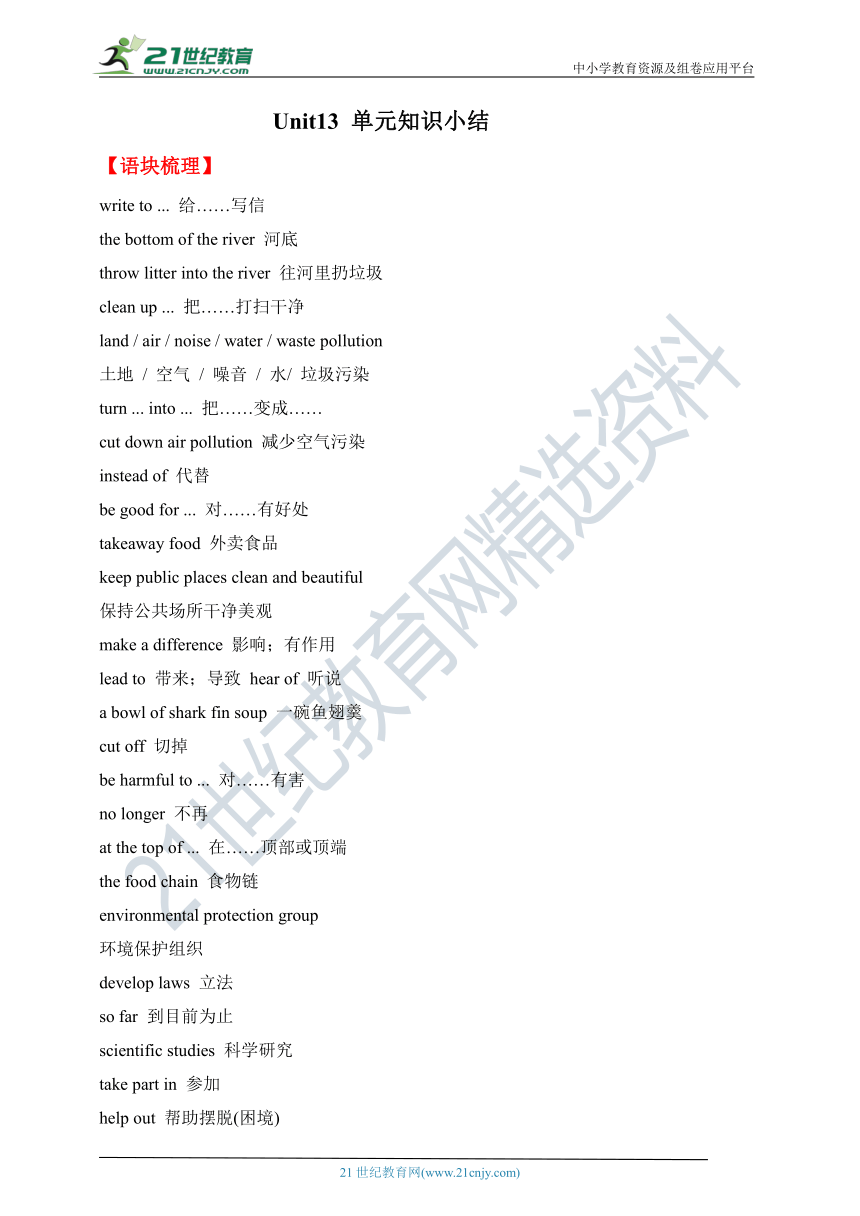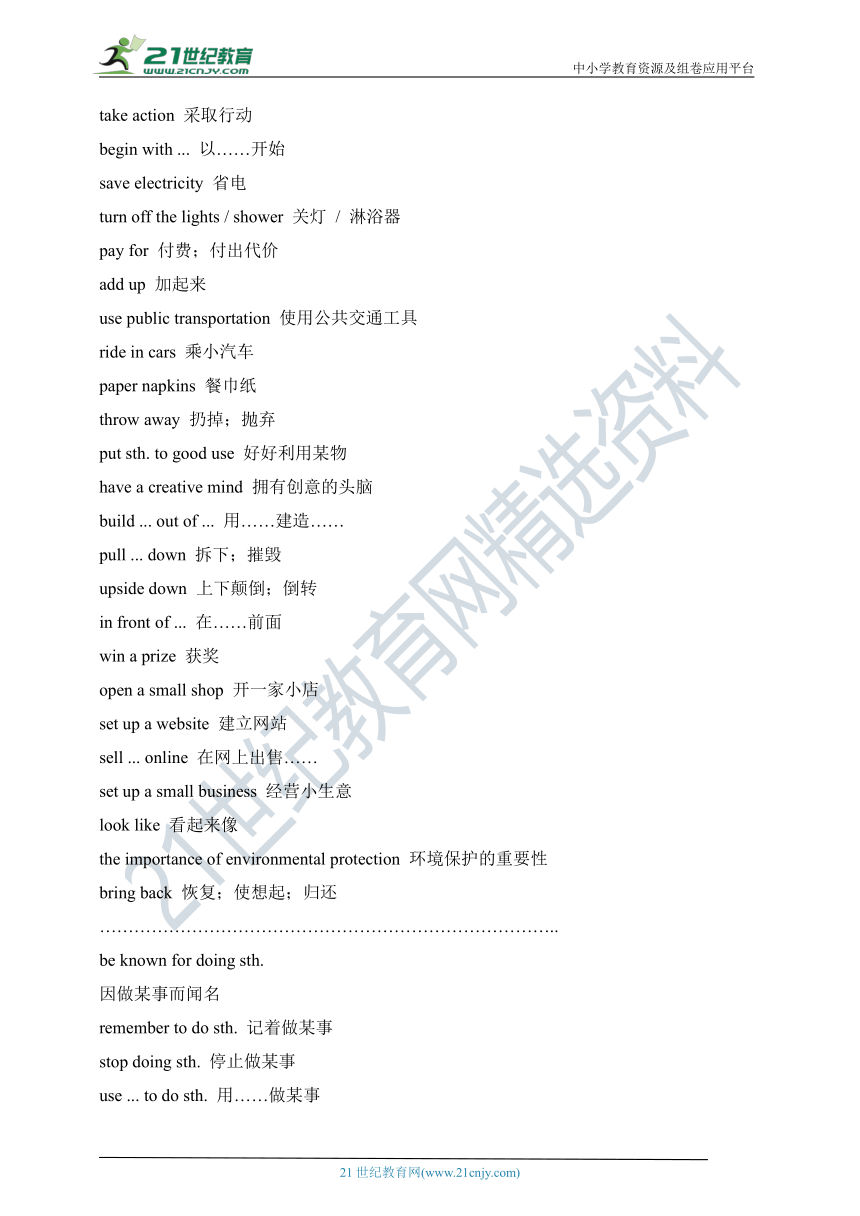Unit13 we're trying to save the earth.单元知识小结
文档属性
| 名称 | Unit13 we're trying to save the earth.单元知识小结 |  | |
| 格式 | doc | ||
| 文件大小 | 151.6KB | ||
| 资源类型 | 试卷 | ||
| 版本资源 | 人教新目标(Go for it)版 | ||
| 科目 | 英语 | ||
| 更新时间 | 2021-12-18 18:59:22 | ||
图片预览


文档简介
中小学教育资源及组卷应用平台
Unit13 单元知识小结
【语块梳理】
write to ... 给……写信
the bottom of the river 河底
throw litter into the river 往河里扔垃圾
clean up ... 把……打扫干净
land / air / noise / water / waste pollution
土地 / 空气 / 噪音 / 水/ 垃圾污染
turn ... into ... 把……变成……
cut down air pollution 减少空气污染
instead of 代替
be good for ... 对……有好处
takeaway food 外卖食品
keep public places clean and beautiful
保持公共场所干净美观
make a difference 影响;有作用
lead to 带来;导致 hear of 听说
a bowl of shark fin soup 一碗鱼翅羹
cut off 切掉
be harmful to ... 对……有害
no longer 不再
at the top of ... 在……顶部或顶端
the food chain 食物链
environmental protection group
环境保护组织
develop laws 立法
so far 到目前为止
scientific studies 科学研究
take part in 参加
help out 帮助摆脱(困境)
take action 采取行动
begin with ... 以……开始
save electricity 省电
turn off the lights / shower 关灯 / 淋浴器
pay for 付费;付出代价
add up 加起来
use public transportation 使用公共交通工具
ride in cars 乘小汽车
paper napkins 餐巾纸
throw away 扔掉;抛弃
put sth. to good use 好好利用某物
have a creative mind 拥有创意的头脑
build ... out of ... 用……建造……
pull ... down 拆下;摧毁
upside down 上下颠倒;倒转
in front of ... 在……前面
win a prize 获奖
open a small shop 开一家小店
set up a website 建立网站
sell ... online 在网上出售……
set up a small business 经营小生意
look like 看起来像
the importance of environmental protection 环境保护的重要性
bring back 恢复;使想起;归还
……………………………………………………………………..
be known for doing sth.
因做某事而闻名
remember to do sth. 记着做某事
stop doing sth. 停止做某事
use ... to do sth. 用……做某事
句子梳理
1. Everyone in this town should play a part in cleaning it up!
2. Jason and Susan, what are your ideas for solving these problems
3. Well, to cut down air pollution, we should take the bus or subway instead of driving.
4. There are other advantages of bike riding.
5. The numbers of some kinds of sharks have fallen by over 90 percent in the last 20 to 30 years.
6. Not only can the art bring happiness to others, but it also shows that even cold, hard iron can be brought back to life with a little creativity.
重点语法
现在进行时
◆用法:表示现在(说话瞬间)正在进行或发生的动作,也可表示当前一段时间内的活动或现阶段正在进行的动作。
◆构成:be (am / is / are)+动词-ing形式。
◆标志性词汇:now, right now, look, listen等。
used to的用法
◆used to意为“过去常常”,表示过去的习惯性动作或状态,其后接动词原形。
◆used to的否定形式是didn't use to;一般疑问句句式为“Did ... use to ... ”。
被动语态
◆当主语为动作的承受者时,谓语要用被动语态,动作的执行者由by 引出。
◆被动语态的构成为“be+及物动词的过去分词”。
◆含情态动词的被动语态的构成为“情态动词+be+及物动词的过去分词”。
现在完成时
◆用法:1. 表示过去发生或已经完成的动作对现在造成的影响或结果。2. 表示过去某一时间开始并一直持续到现在(包括“现在”在内)的动作或状态。这种用法中的动词多是延续性动词。
◆构成:have / has+动词的过去分词。
◆标志性词汇:already, yet, ever, never, just, before, once, twice, recently, for, since, so far, in the past / last ...等。
情态动词
◆情态动词本身有一定的意义,表示说话人的情绪、态度和语气,但不能单独作谓语。初中阶段常见的情态动词有can (could), may (might), must / have to, need, shall (should), will (would)等。
◆情态动词无人称和数的变化(have to除外),其后跟动词原形。个别情态动词有过去式(如can→could),除表示时态外,还可用来表达更加客气、委婉的语气。
◆情态动词有一个很重要的用法,即情态动词表示推测。在肯定句中,有把握的推测用must,意为“一定;肯定”;把握不大的推测用could或might。在否定句中,有把握的推测用can't,意为“不可能”。
21世纪教育网 www.21cnjy.com 精品试卷·第 2 页 (共 2 页)
HYPERLINK "http://21世纪教育网(www.21cnjy.com)
" 21世纪教育网(www.21cnjy.com)
Unit13 单元知识小结
【语块梳理】
write to ... 给……写信
the bottom of the river 河底
throw litter into the river 往河里扔垃圾
clean up ... 把……打扫干净
land / air / noise / water / waste pollution
土地 / 空气 / 噪音 / 水/ 垃圾污染
turn ... into ... 把……变成……
cut down air pollution 减少空气污染
instead of 代替
be good for ... 对……有好处
takeaway food 外卖食品
keep public places clean and beautiful
保持公共场所干净美观
make a difference 影响;有作用
lead to 带来;导致 hear of 听说
a bowl of shark fin soup 一碗鱼翅羹
cut off 切掉
be harmful to ... 对……有害
no longer 不再
at the top of ... 在……顶部或顶端
the food chain 食物链
environmental protection group
环境保护组织
develop laws 立法
so far 到目前为止
scientific studies 科学研究
take part in 参加
help out 帮助摆脱(困境)
take action 采取行动
begin with ... 以……开始
save electricity 省电
turn off the lights / shower 关灯 / 淋浴器
pay for 付费;付出代价
add up 加起来
use public transportation 使用公共交通工具
ride in cars 乘小汽车
paper napkins 餐巾纸
throw away 扔掉;抛弃
put sth. to good use 好好利用某物
have a creative mind 拥有创意的头脑
build ... out of ... 用……建造……
pull ... down 拆下;摧毁
upside down 上下颠倒;倒转
in front of ... 在……前面
win a prize 获奖
open a small shop 开一家小店
set up a website 建立网站
sell ... online 在网上出售……
set up a small business 经营小生意
look like 看起来像
the importance of environmental protection 环境保护的重要性
bring back 恢复;使想起;归还
……………………………………………………………………..
be known for doing sth.
因做某事而闻名
remember to do sth. 记着做某事
stop doing sth. 停止做某事
use ... to do sth. 用……做某事
句子梳理
1. Everyone in this town should play a part in cleaning it up!
2. Jason and Susan, what are your ideas for solving these problems
3. Well, to cut down air pollution, we should take the bus or subway instead of driving.
4. There are other advantages of bike riding.
5. The numbers of some kinds of sharks have fallen by over 90 percent in the last 20 to 30 years.
6. Not only can the art bring happiness to others, but it also shows that even cold, hard iron can be brought back to life with a little creativity.
重点语法
现在进行时
◆用法:表示现在(说话瞬间)正在进行或发生的动作,也可表示当前一段时间内的活动或现阶段正在进行的动作。
◆构成:be (am / is / are)+动词-ing形式。
◆标志性词汇:now, right now, look, listen等。
used to的用法
◆used to意为“过去常常”,表示过去的习惯性动作或状态,其后接动词原形。
◆used to的否定形式是didn't use to;一般疑问句句式为“Did ... use to ... ”。
被动语态
◆当主语为动作的承受者时,谓语要用被动语态,动作的执行者由by 引出。
◆被动语态的构成为“be+及物动词的过去分词”。
◆含情态动词的被动语态的构成为“情态动词+be+及物动词的过去分词”。
现在完成时
◆用法:1. 表示过去发生或已经完成的动作对现在造成的影响或结果。2. 表示过去某一时间开始并一直持续到现在(包括“现在”在内)的动作或状态。这种用法中的动词多是延续性动词。
◆构成:have / has+动词的过去分词。
◆标志性词汇:already, yet, ever, never, just, before, once, twice, recently, for, since, so far, in the past / last ...等。
情态动词
◆情态动词本身有一定的意义,表示说话人的情绪、态度和语气,但不能单独作谓语。初中阶段常见的情态动词有can (could), may (might), must / have to, need, shall (should), will (would)等。
◆情态动词无人称和数的变化(have to除外),其后跟动词原形。个别情态动词有过去式(如can→could),除表示时态外,还可用来表达更加客气、委婉的语气。
◆情态动词有一个很重要的用法,即情态动词表示推测。在肯定句中,有把握的推测用must,意为“一定;肯定”;把握不大的推测用could或might。在否定句中,有把握的推测用can't,意为“不可能”。
21世纪教育网 www.21cnjy.com 精品试卷·第 2 页 (共 2 页)
HYPERLINK "http://21世纪教育网(www.21cnjy.com)
" 21世纪教育网(www.21cnjy.com)
同课章节目录
- Unit 1 How can we become good learners.
- Section A
- Section B
- Unit 2 I think that mooncakes are delicious!
- Section A
- Section B
- Unit 3 Could you please tell me where the restroom
- Section A
- Section B
- Unit 4 I used to be afraid of the dark.
- Section A
- Section B
- Unit 5 What are the shirts made of?
- Section A
- Section B
- Review of Units 1-5
- Unit 6 When was it invented?
- Section A
- Section B
- Unit 7 Teenagers should be allowed to choose their
- Section A
- Section B
- Unit 8 It must belong to Carla.
- Section A
- Section B
- Unit 9 I like music that I can dance to.
- Section A
- Section B
- Unit 10 You're supposed to shake hands.
- Section A
- Section B
- Review of Units 6-10
- Unit 11 Sad movies make me cry.
- Section A
- Section B
- Unit 12 Life is full of the unexpected
- Section A
- Section B
- Unit 13 We're trying to save the earth!
- Section A
- Section B
- Unit 14 I remember meeting all of you in Grade 7.
- Section A
- Section B
- Review of Units 11-14
